Surfaces, Interfaces, Molecules & 2D Materials (SIM2D)
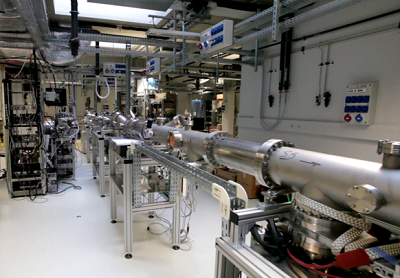 The research topics of the SIM2D team tackle the physical and chemical properties of molecular systems, 2D materials and nanoclusters adsorbed on surfaces. Our objective is to measure the electronic and structural characteristics resulting from the mutual interactions. For instance, reactive species adsorbed on a surface can undergo a spontaneous nanostructuration. For self-assembled molecular layers, the interactions depend on the density and number of layers. STM and GIFAD provide direct observation of the molecular organization, while molecular spectroscopy (HREELS) can identify specific molecular terminations, their orientation, and environment. Well controlled low energy electrons are also used to induce energy specific reactions and to graft specific terminations. Most techniques described below are now connected to an ultra-high vacuum tunnel allowing a multi-technique appraoch to the same system. The applications span astrophysics, radiobiology, thin layer growth, molecular electronics, chemical and biological sensors
The research topics of the SIM2D team tackle the physical and chemical properties of molecular systems, 2D materials and nanoclusters adsorbed on surfaces. Our objective is to measure the electronic and structural characteristics resulting from the mutual interactions. For instance, reactive species adsorbed on a surface can undergo a spontaneous nanostructuration. For self-assembled molecular layers, the interactions depend on the density and number of layers. STM and GIFAD provide direct observation of the molecular organization, while molecular spectroscopy (HREELS) can identify specific molecular terminations, their orientation, and environment. Well controlled low energy electrons are also used to induce energy specific reactions and to graft specific terminations. Most techniques described below are now connected to an ultra-high vacuum tunnel allowing a multi-technique appraoch to the same system. The applications span astrophysics, radiobiology, thin layer growth, molecular electronics, chemical and biological sensors
Plateforme Technique de Faisceau d’ions (FIB)
|
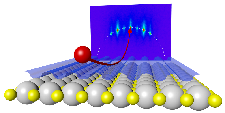 After discovering that fast (keV) atoms can diffract on crystal surfaces, we have developped the technique. It can image large dimensions of the crystal surface with a resolution reaching 10 pm. The inelastic component highlights surface defects (steps, ad-atoms) and dynamical aspects of the surface (vibrational excitations, electron-hole pair creations..). After discovering that fast (keV) atoms can diffract on crystal surfaces, we have developped the technique. It can image large dimensions of the crystal surface with a resolution reaching 10 pm. The inelastic component highlights surface defects (steps, ad-atoms) and dynamical aspects of the surface (vibrational excitations, electron-hole pair creations..).
Read more
|
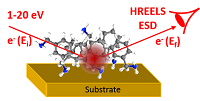 Low-energy electron beams of controlled energy make it possible both, to analyse the chemical compositions of surfaces and interfaces, and to induce specific chemical reactions. The aims of the work carried out concern the identification of the species and interaction mechanisms involved, and the quantitative evaluation of the efficiency of the chemical processes induced under radiation. Low-energy electron beams of controlled energy make it possible both, to analyse the chemical compositions of surfaces and interfaces, and to induce specific chemical reactions. The aims of the work carried out concern the identification of the species and interaction mechanisms involved, and the quantitative evaluation of the efficiency of the chemical processes induced under radiation.
Read more
|
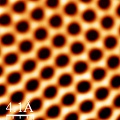
Silicene forms a buckled honeycomb structure when grown on many surfaces as single layers or nanowires. The first experimental observations (APL 2010, 97, 223109) confirmed the initial theoretical proposals. Self-assembled silicene nanoribbons and silicene sheets deposited on different crystalline surfaces are studied with STM.
Techniques: RT STM - LT STM - SXRD - ALE - AES - LEED - Synchrotron
Read more
|
|
 By combining local probe (STM) and electronic spectroscopies (XPS/UPS) the group interest is focused on the study and control of formation of organic molecular layers on surfaces at meso/macro scale and aim at using its experience in chemical reactivity induced nano-structuration of metal surfaces to use them as original substrate morphologies. By combining local probe (STM) and electronic spectroscopies (XPS/UPS) the group interest is focused on the study and control of formation of organic molecular layers on surfaces at meso/macro scale and aim at using its experience in chemical reactivity induced nano-structuration of metal surfaces to use them as original substrate morphologies.
Read more
|
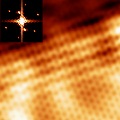
STM topography and I(V), I(Z) and Z(V) spectroscopies are used to study the atomic-scale structural, electronic and electron transport properties of graphene epitaxially grown on SiC substrates. STM is also used to investigate self-assembling and reactivity of molecules on graphene with the aim to locally modify the electronic properties of graphene.
Techniques: Room temperature STM - STS, UHV, molecular deposition
Read more
|

In systems with strongly interacting fermions, the competition between the different degrees of freedom leads to competing quantum ground states, from which a rich variety of macroscopic phenomena emerge. In many cases, these phenomena arise from phase transitions described by exotic (or even unknown) order parameters and underlying novel states of matter. As such, the physics of strongly-interacting fermions is the common thread in several challenging open problems.
Read more
|
|
 Objectives: create metal-molecule ordered héterostructures as well as chalcogenide materials, families of low dimensional materials with novel properties of interest in applications such as molecular electronics. We do this using synchrotron radiation, complemented by scanning tunnelling microscopy and ion scattering. Objectives: create metal-molecule ordered héterostructures as well as chalcogenide materials, families of low dimensional materials with novel properties of interest in applications such as molecular electronics. We do this using synchrotron radiation, complemented by scanning tunnelling microscopy and ion scattering.
Read more
|
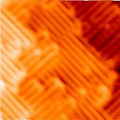
Transparent wide band-gap materials play a crucial role in many applications ranging from high power micro-electronics, and opto-electronics ranging from photo-voltaic cells to photo-catalysis. For Diamond, Silicon carbide and oxide materials to be used in nanoscale applications, several challenges must be overcome. These include surface preparation, atomic-scale characterisation, efficient doping, conductivity and molecular adsorption.
Techniques: UHV NC AFM - RT STM - LEED - H Plasma - Atomic Layer Epitaxy (ALE)
Read more
|
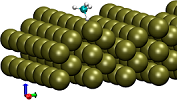
Nos études portent sur la dynamique et la réactivité des atomes et des molécules en phase gazeuse ou en interaction avec des surfaces. Notre objectif est d’obtenir des probabilités de réaction, de déterminer la répartition de l’énergie entre la surface, le mouvement de translation et les degrés de liberté internes des produits, de caractériser l’effet de surface sur les réactions chimiques. Ces études sont développées dans le contexte des nanosciences.
Read more
|
 The research topics of the SIM2D team tackle the physical and chemical properties of molecular systems, 2D materials and nanoclusters adsorbed on surfaces. Our objective is to measure the electronic and structural characteristics resulting from the mutual interactions. For instance, reactive species adsorbed on a surface can undergo a spontaneous nanostructuration. For self-assembled molecular layers, the interactions depend on the density and number of layers. STM and GIFAD provide direct observation of the molecular organization, while molecular spectroscopy (HREELS) can identify specific molecular terminations, their orientation, and environment. Well controlled low energy electrons are also used to induce energy specific reactions and to graft specific terminations. Most techniques described below are now connected to an ultra-high vacuum tunnel allowing a multi-technique appraoch to the same system. The applications span astrophysics, radiobiology, thin layer growth, molecular electronics, chemical and biological sensors
The research topics of the SIM2D team tackle the physical and chemical properties of molecular systems, 2D materials and nanoclusters adsorbed on surfaces. Our objective is to measure the electronic and structural characteristics resulting from the mutual interactions. For instance, reactive species adsorbed on a surface can undergo a spontaneous nanostructuration. For self-assembled molecular layers, the interactions depend on the density and number of layers. STM and GIFAD provide direct observation of the molecular organization, while molecular spectroscopy (HREELS) can identify specific molecular terminations, their orientation, and environment. Well controlled low energy electrons are also used to induce energy specific reactions and to graft specific terminations. Most techniques described below are now connected to an ultra-high vacuum tunnel allowing a multi-technique appraoch to the same system. The applications span astrophysics, radiobiology, thin layer growth, molecular electronics, chemical and biological sensors










